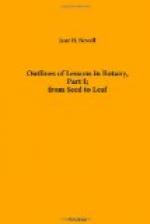[Footnote 1: Reader in Botany. II. The Cotton Plant.]
3. Purification of the Air.—The following questions and experiments are intended to show the pupils, first, that we live in an atmosphere, the presence of which is necessary to support life and combustion (1) and (2); secondly, that this atmosphere is deprived of its power to support life and combustion by the actions of combustion (2), and of respiration (3); thirdly, that this power is restored to the air by the action of plants (4).
We have the air about us everywhere. A so-called empty vessel is one where the contents are invisible. The following experiment is a good illustration of this.
(1) Wrap the throat of a glass funnel with moistened cloth or paper so that it will fit tightly into the neck of a bottle, and fill the funnel with water. If the space between the funnel and the bottle is air-tight, the water will not flow into the bottle.
[Illustration: FIG. 1.]
Do not explain this in advance to the pupils. Ask them what prevents the water from flowing into the bottle. If they are puzzled, loosen the funnel, and show them that the water will now flow in. In the first case, as the air could not escape, the water could not flow in; in the second, the air was displaced by the heavier water.
Ask the pupils why the air in a crowded room becomes so difficult to breathe. Could a person live if he were shut up in an air-tight room for a long time? Fresh air is necessary to life. The teacher may explain that it is the oxygen in the air that supports life. Air is composed one-fifth of this gas and four-fifths of nitrogen. The gases are mixed and the nitrogen simply dilutes the oxygen, as it were.
Fresh air is necessary to support combustion as well as life. Ask them why we put out a fire by throwing a blanket or a rug over it. The following experiment illustrates this.
(2) Take a small, wide-mouthed bottle, covered with a card or cork. To this cover fasten a piece of bent wire with a taper on the end. Light the taper and lower it into the jar. It will burn a few seconds and then go out. Raise and light it again, and it will be extinguished as soon as it is plunged into the bottle. This shows that the oxygen of the air is used up by burning substances, as it is by breathing animals.
[Illustration: FIG. 2.]
The following experiment shows that fire will not burn in an atmosphere of gas from our lungs.
(3) Fill a bottle with gas by breathing into it through a bit of glass tubing, passed through a card or cork, and reaching to the bottom of the bottle. The bottle will be dimmed with moisture, showing the presence of aqueous vapor. A lighted match plunged into the bottle will be immediately extinguished. A better way, which, however, takes some skill in manipulation, is to fill the bottle with water, cover it with a flat piece of glass, and invert the bottle




